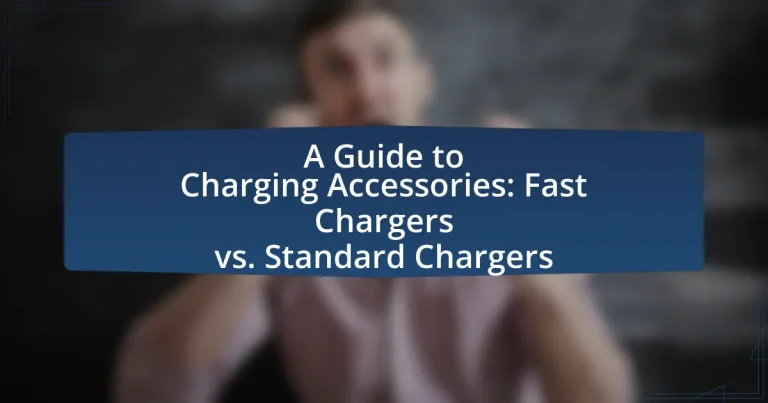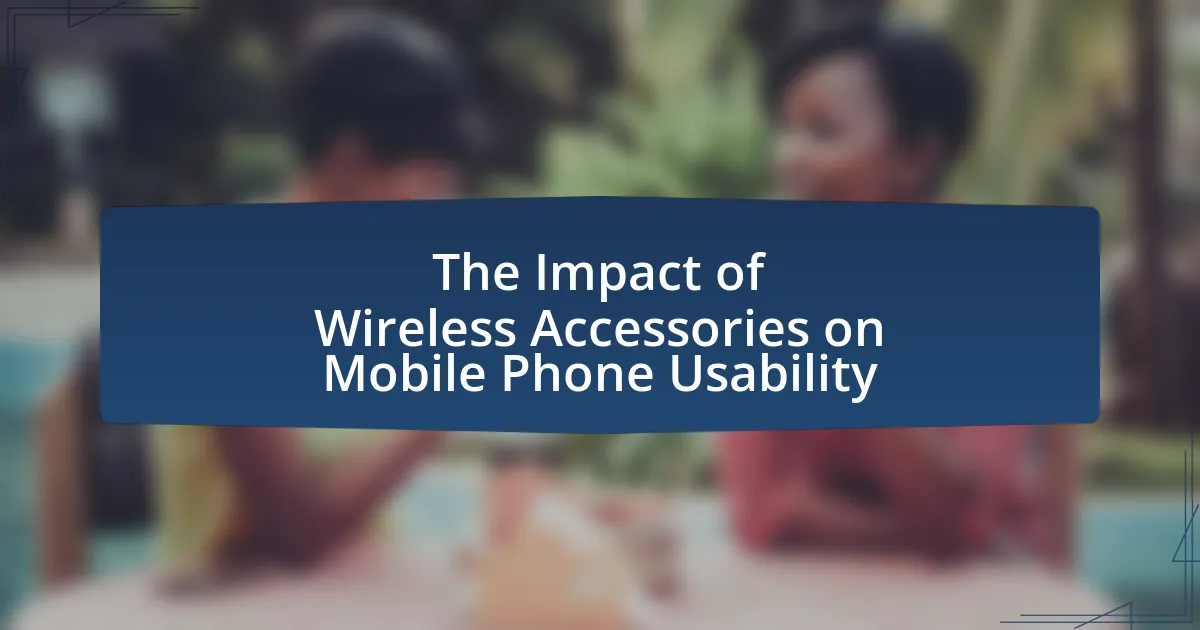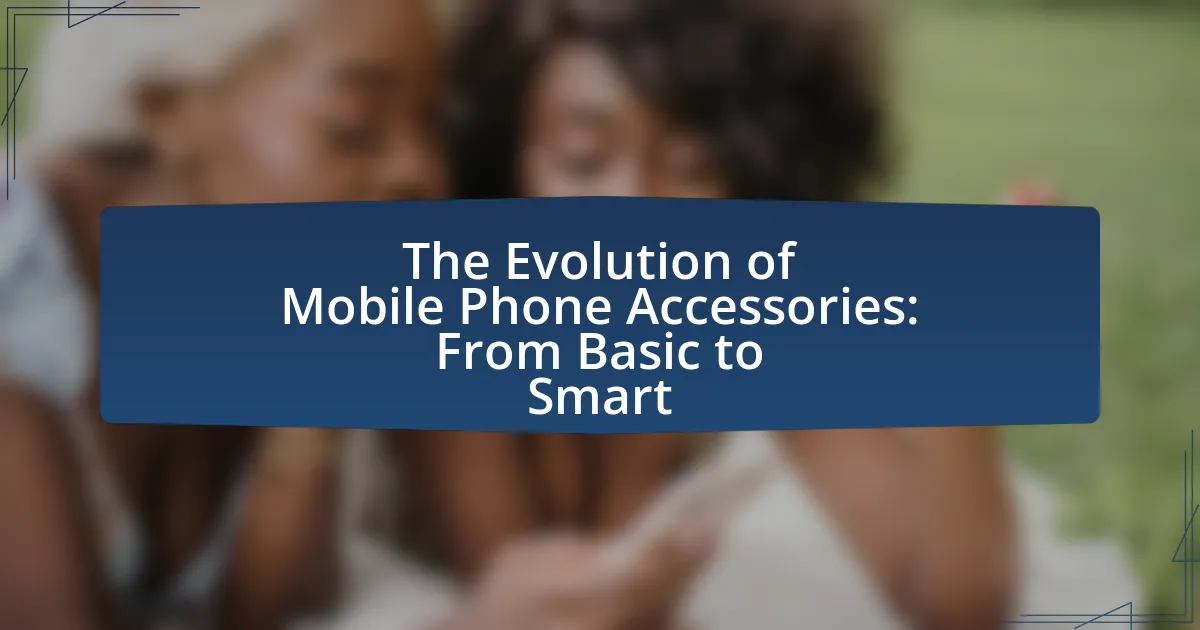Charging accessories are essential devices that enable the charging of electronic gadgets such as smartphones, tablets, and laptops. This article provides a comprehensive overview of charging accessories, focusing on the differences between fast chargers and standard chargers. Key topics include the functionality of charging accessories, essential components that influence charging speed, and the various types available. Additionally, the article examines the advantages and disadvantages of each charger type, factors to consider when selecting a charger, and best practices for maximizing the lifespan of charging accessories. Understanding these elements is crucial for optimizing device performance and ensuring safe charging practices.
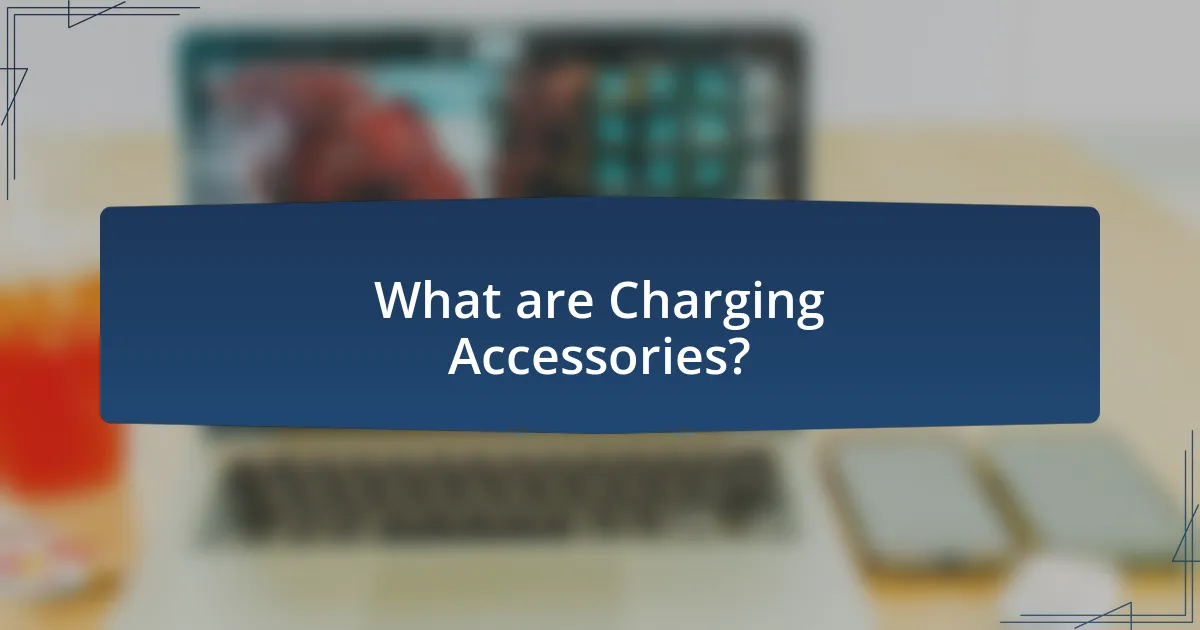
What are Charging Accessories?
Charging accessories are devices and components that facilitate the charging of electronic devices, such as smartphones, tablets, and laptops. These accessories include items like chargers, cables, power banks, and charging docks, which are essential for providing power to devices. For instance, fast chargers can deliver higher wattage to charge devices more quickly compared to standard chargers, which typically provide lower wattage. The effectiveness of charging accessories is supported by specifications such as the USB Power Delivery standard, which allows for faster charging capabilities when compatible devices are used.
How do Charging Accessories function?
Charging accessories function by converting electrical energy from a power source into a form that can be used to recharge electronic devices. These accessories, such as chargers and cables, facilitate the transfer of power through various mechanisms, including voltage regulation and current control, ensuring that devices receive the appropriate amount of energy for efficient charging. For instance, fast chargers utilize higher voltage and current levels to reduce charging time, while standard chargers operate at lower levels, providing a slower charge. The effectiveness of these accessories is supported by their adherence to specific charging standards, such as USB Power Delivery, which optimizes power delivery based on device requirements.
What components are essential in Charging Accessories?
Essential components in charging accessories include the power adapter, charging cable, connectors, and safety features. The power adapter converts AC to DC power, while the charging cable transmits electricity from the adapter to the device. Connectors, such as USB or Lightning, ensure compatibility with various devices. Safety features, including overcurrent protection and temperature control, prevent damage to both the charger and the device being charged. These components work together to provide efficient and safe charging solutions.
How do these components influence charging speed?
Charging speed is influenced by components such as the charger, cable, and device compatibility. Fast chargers typically provide higher wattage, allowing for quicker energy transfer to the device. For instance, a charger rated at 18W can charge a compatible device significantly faster than a standard 5W charger. Additionally, the quality and specifications of the charging cable, such as its gauge and material, affect the efficiency of power delivery. A high-quality cable designed for fast charging minimizes resistance and heat loss, further enhancing charging speed. Lastly, the device’s ability to accept higher power levels, determined by its internal circuitry, plays a crucial role; devices that support fast charging protocols can utilize the full potential of fast chargers, resulting in reduced charging times.
What types of Charging Accessories are available?
Charging accessories include wall chargers, car chargers, power banks, wireless chargers, and charging cables. Wall chargers provide a direct power source for devices, while car chargers allow charging on the go. Power banks offer portable energy storage for charging devices without a direct power source. Wireless chargers enable contactless charging through electromagnetic fields. Charging cables connect devices to power sources and come in various types, such as USB-C, Lightning, and Micro-USB, catering to different devices and charging speeds.
What distinguishes Fast Chargers from Standard Chargers?
Fast Chargers are distinguished from Standard Chargers primarily by their ability to deliver higher power output, resulting in significantly reduced charging times. Fast Chargers typically utilize advanced technologies such as Power Delivery (PD) or Qualcomm Quick Charge, allowing them to provide power levels ranging from 18 watts to over 100 watts, while Standard Chargers usually operate at lower power levels, often around 5 to 12 watts. This difference in power output enables Fast Chargers to charge compatible devices up to 70% faster than Standard Chargers, making them more efficient for users who require quick recharges.
What are the common features of each type?
Fast chargers and standard chargers share several common features, including compatibility with various devices, the ability to provide power through USB connections, and built-in safety mechanisms to prevent overheating and overcharging. Both types typically utilize similar charging ports, such as USB-A or USB-C, ensuring they can connect to a wide range of smartphones, tablets, and other electronic devices. Additionally, they often include features like LED indicators to show charging status, making it easy for users to monitor the charging process.
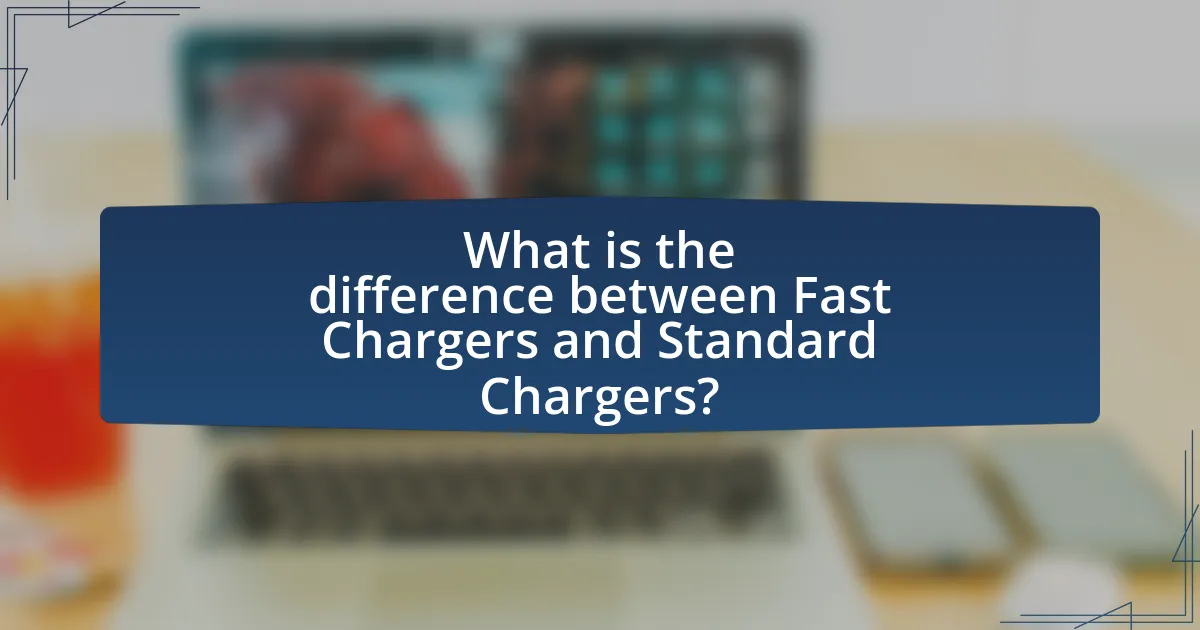
What is the difference between Fast Chargers and Standard Chargers?
Fast chargers deliver power at a higher rate compared to standard chargers, significantly reducing charging time. Fast chargers typically use higher voltage and current levels, allowing devices to charge up to 70% faster than standard chargers, which usually operate at lower power levels. For example, a fast charger may provide 18W or more, while a standard charger often provides around 5W. This difference in charging speed is crucial for users who need quick power boosts for their devices.
How does charging speed vary between Fast and Standard Chargers?
Fast chargers significantly increase charging speed compared to standard chargers, often providing power levels of 18W to 100W or more, while standard chargers typically offer around 5W to 12W. This difference in wattage results in fast chargers being able to charge devices up to four to five times quicker than standard chargers, depending on the device’s compatibility with fast charging technology. For example, a smartphone that supports fast charging can reach 50% battery in approximately 30 minutes with a fast charger, whereas a standard charger may take over two hours to achieve the same level.
What factors contribute to the speed of Fast Chargers?
The speed of fast chargers is primarily influenced by three factors: power output, charging protocol, and battery chemistry. Power output, measured in watts, determines how quickly energy can be delivered to the device; for instance, a charger with a 65W output can charge a compatible device significantly faster than a 5W charger. Charging protocols, such as Qualcomm Quick Charge or USB Power Delivery, optimize the communication between the charger and the device to manage power flow efficiently, allowing for higher charging speeds. Lastly, battery chemistry, particularly lithium-ion technology, affects how quickly a battery can accept charge; advanced lithium-ion batteries can handle higher currents without overheating, enabling faster charging rates.
Why might someone choose a Standard Charger over a Fast Charger?
Someone might choose a Standard Charger over a Fast Charger primarily due to safety and battery longevity concerns. Standard Chargers typically provide a lower voltage and current, which reduces the risk of overheating and potential damage to the device’s battery. Research indicates that charging a lithium-ion battery at a slower rate can extend its lifespan, as rapid charging can lead to increased heat and stress on the battery cells. Therefore, users prioritizing device safety and battery health may prefer Standard Chargers for their more gradual charging process.
What are the advantages and disadvantages of each type?
Fast chargers provide the advantage of significantly reduced charging time, allowing devices to reach full battery capacity in a fraction of the time compared to standard chargers. This is particularly beneficial for users who need quick power boosts during busy schedules. However, the disadvantage of fast chargers includes the potential for increased heat generation, which can lead to battery degradation over time if used excessively.
Standard chargers, on the other hand, offer the advantage of being gentler on the battery, promoting longer battery lifespan due to lower heat output during charging. They are also typically more affordable and widely compatible with various devices. The disadvantage of standard chargers is their slower charging speed, which can be inconvenient for users who require quick recharges.
What benefits do Fast Chargers provide?
Fast chargers provide the benefit of significantly reduced charging time for electronic devices. By utilizing higher voltage and current levels, fast chargers can recharge batteries to a substantial percentage in a fraction of the time compared to standard chargers. For instance, a fast charger can often charge a smartphone to 50% in about 30 minutes, while a standard charger may take over an hour to achieve the same level. This efficiency is particularly advantageous for users with busy lifestyles, as it allows for quick top-ups during short breaks.
What limitations should users consider with Standard Chargers?
Standard chargers have several limitations that users should consider, primarily slower charging speeds compared to fast chargers. For instance, standard chargers typically provide a maximum output of 5 watts, which can significantly extend the time required to fully charge devices, especially larger ones like tablets or smartphones with high-capacity batteries. Additionally, standard chargers may lack compatibility with newer fast-charging technologies, which can limit their effectiveness with modern devices designed to utilize higher wattage for quicker charging. Furthermore, users may find that standard chargers do not support features like power delivery or quick charge protocols, which are essential for optimizing charging efficiency.
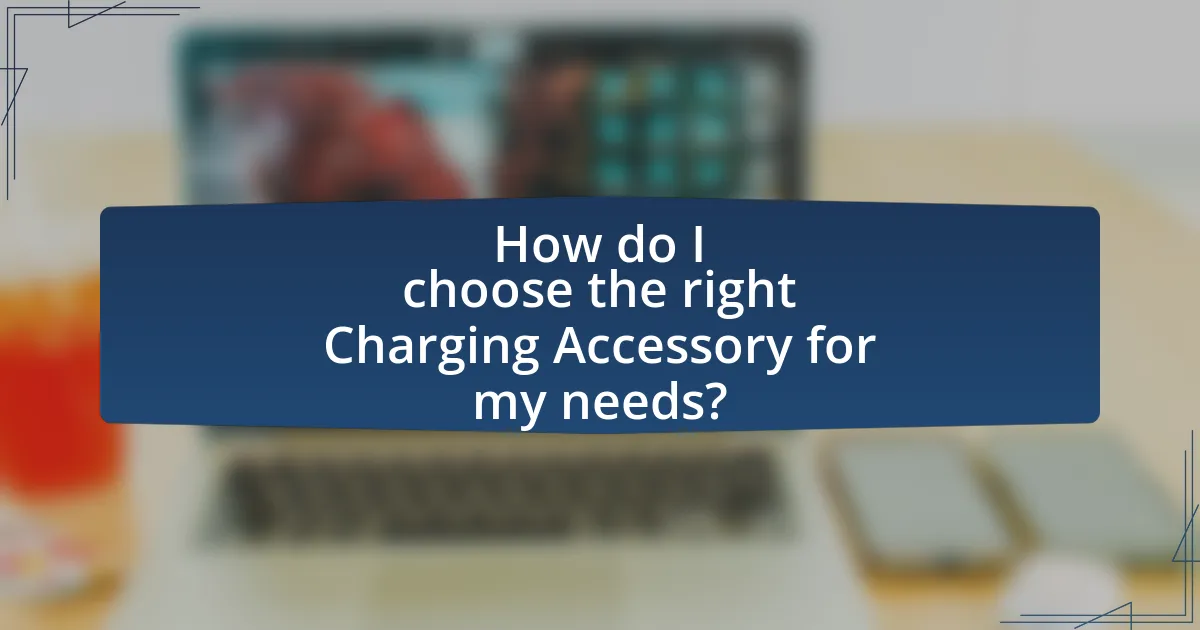
How do I choose the right Charging Accessory for my needs?
To choose the right charging accessory for your needs, assess your device’s compatibility, charging speed requirements, and usage scenarios. For instance, if your device supports fast charging, select a fast charger that matches its specifications, such as wattage and connector type. Research indicates that using the appropriate charger can enhance charging efficiency and battery longevity, as fast chargers can reduce charging time significantly compared to standard chargers. Therefore, understanding your device’s requirements and the capabilities of various charging accessories is crucial for optimal performance.
What factors should I consider when selecting a charger?
When selecting a charger, consider the device compatibility, charging speed, power output, and safety features. Device compatibility ensures that the charger can effectively power your specific device, while charging speed is determined by the charger’s wattage; for example, a 20W charger will charge devices faster than a 5W charger. Power output, measured in volts and amps, should match the device’s requirements to prevent damage. Safety features, such as overcurrent protection and temperature control, are crucial to prevent overheating and ensure safe charging. These factors collectively influence the efficiency and safety of the charging process.
How does device compatibility affect charger choice?
Device compatibility significantly influences charger choice by determining which chargers can effectively power or charge a specific device. For instance, smartphones and laptops often require chargers that meet specific voltage and amperage standards; using an incompatible charger can lead to inefficient charging or even damage the device. According to the USB Implementers Forum, devices that support USB Power Delivery can charge faster with compatible chargers, highlighting the importance of matching charger specifications to device requirements.
What role does charging speed play in my decision?
Charging speed significantly influences your decision when selecting charging accessories, as it determines how quickly your device can regain power. Fast chargers can provide up to 50% charge in just 30 minutes, compared to standard chargers that may take several hours for the same amount of power. This difference is crucial for users who rely on their devices throughout the day and need quick top-ups during short breaks. Additionally, faster charging can enhance the overall user experience by minimizing downtime, making it a key factor in choosing between fast and standard chargers.
What are some best practices for using Charging Accessories?
To ensure optimal performance and safety when using charging accessories, users should follow several best practices. First, always use the manufacturer-recommended charging cables and adapters, as they are designed to meet the specific power requirements of the device, reducing the risk of overheating or damage. Second, avoid using damaged or frayed cables, as they can pose safety hazards and lead to inefficient charging. Third, keep charging accessories away from extreme temperatures and moisture, as these conditions can affect their functionality and lifespan. Additionally, unplug chargers when not in use to prevent energy waste and potential hazards. Lastly, regularly inspect charging ports for debris and clean them gently to maintain a good connection. These practices are supported by safety guidelines from organizations such as the Consumer Electronics Association, which emphasize the importance of using compatible and undamaged accessories for device longevity and user safety.
How can I maximize the lifespan of my chargers?
To maximize the lifespan of chargers, avoid exposing them to extreme temperatures and humidity. Chargers function optimally within a temperature range of 0 to 40 degrees Celsius; exceeding this range can lead to overheating and damage. Additionally, regularly inspect the charging cables for fraying or damage, as compromised cables can cause short circuits. Using chargers that are compatible with your devices also prevents unnecessary strain on the charger, which can extend its life. According to a study by the Consumer Electronics Association, proper care and usage can increase the longevity of electronic accessories by up to 50%.
What common mistakes should I avoid when using chargers?
Common mistakes to avoid when using chargers include overcharging devices, using incompatible chargers, and exposing chargers to extreme temperatures. Overcharging can lead to battery degradation, as lithium-ion batteries typically require a specific voltage range for optimal performance. Using incompatible chargers may result in insufficient power delivery or damage to the device, as different devices have varying voltage and current requirements. Additionally, exposing chargers to extreme temperatures can cause overheating, which may lead to safety hazards or reduced charger lifespan.
